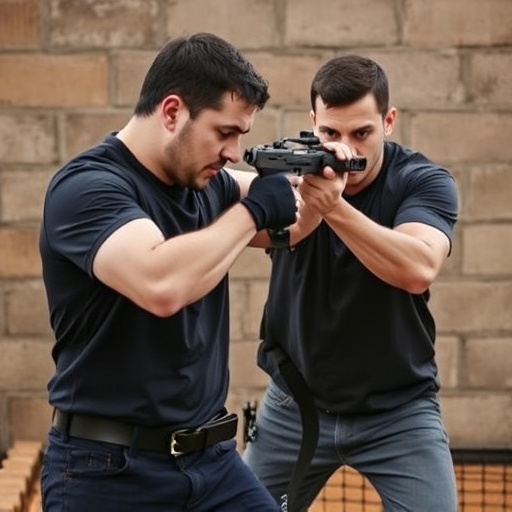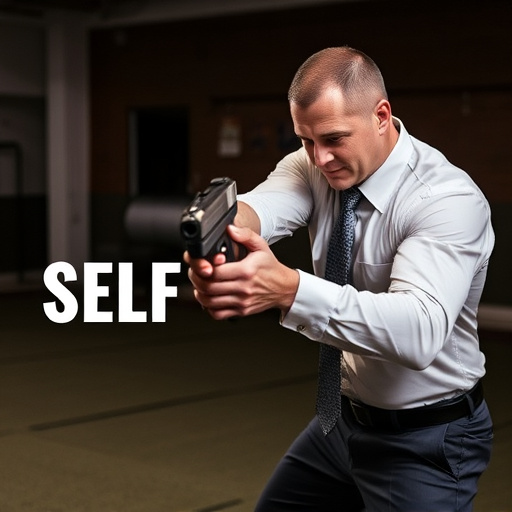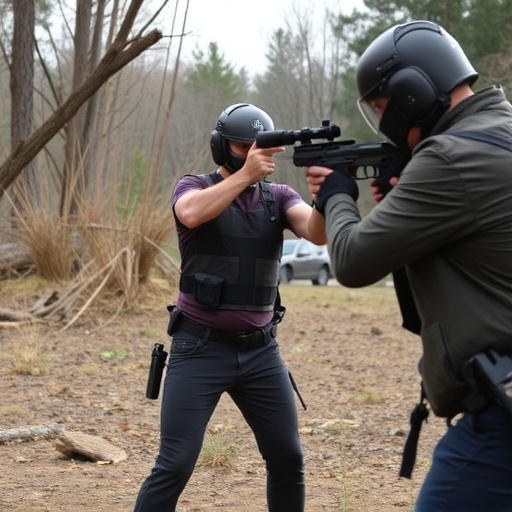A stun gun, or electronic control device (ECD), temporarily disables targets by overwhelming their nervous system with a high-voltage, low-current electrical pulse. This disrupts brain signal transmission to muscles, causing involuntary contractions, disorientation, and fear. Beyond physical paralysis, stun guns can induce sensory disturbances and temporary vision impairment. Their distinctive sound and light flash trigger powerful psychological responses, altering behavior and decision-making. Sound deterrent features further enhance safety by leveraging the sensitivity of the human ear to specific frequencies, deterring attackers through temporary disorientation or discomfort, ultimately ensuring more effective self-defense against dangerous scenarios.
Stun guns, also known as electronic control devices (ECDs), have gained prominence as non-lethal weapons for personal defense. Beyond their electrical discharge, modern stun guns incorporate sound deterrent features that significantly enhance safety and effectiveness. This article delves into the science behind stun guns, exploring how they disrupt the nervous system through electric current. We also examine the physiological effects of a stun gun shot and its psychological impact on behavior modification. Specifically, we highlight the role of sound deterrents in augmenting the overall safety and success of these devices.
- Understanding the Stun Gun's Mechanism of Action on the Nervous System
- The Physiological Effects of a Stun Gun Shot
- Psychological Impact and Behavior Modification
- Sound Deterrent Features: How They Enhance Safety and Effectiveness
Understanding the Stun Gun's Mechanism of Action on the Nervous System

A stun gun, or electronic control device (ECD), works by delivering a powerful electric shock to disrupt the normal functioning of the human nervous system. When activated, the stun gun generates a high-voltage, low-current electrical pulse that interferes with the brain’s ability to send signals to muscles, causing temporary incapacitation. This disruption is achieved through two primary means: nerve stimulation and muscle contraction.
The shock from a stun gun overloads the nervous system, specifically targeting motor neurons responsible for controlling voluntary muscle movements. This overload results in a protective response known as a “nerve impulse blocking effect,” where electrical impulses are blocked or disrupted, leading to involuntary muscle contractions and twitches. The intense but short-duration shock also triggers a release of neurotransmitters and neuromodulators, further exacerbating the disorienting effects and ensuring the individual is incapacitated long enough for the authorities to intervene.
The Physiological Effects of a Stun Gun Shot

When a stun gun discharges, it releases an electric current that targets the nervous system. This sudden jolt disrupts the brain’s ability to send signals to muscles, leading to temporary paralysis. The effect is swift and can cause the target to fall to the ground, immobilized for several minutes. This disruption isn’t just physical; the intense pain and disorientation can also induce fear and confusion, making it an effective deterrent in potential assault situations.
The stun gun’s impact on the body extends beyond immediate muscle paralysis. The electric current can cause sensory disturbances, such as numbness or tingling sensations, and even temporary vision impairment. These physiological effects serve to neutralize a threat actor quickly and safely for both the user and the target, making stun guns a popular personal defense tool.
Psychological Impact and Behavior Modification

The stun gun, with its loud and distinct sound, is more than just a physical deterrent; it triggers a powerful psychological response that can modify behavior. The high-pitched tone and intense flash of light stimulate the nervous system, causing an immediate reaction in the target. This sudden activation disrupts their sensory perception, creating a sense of fear and disorientation. The effects on the nervous system are significant, leading to muscle spasms, reduced motor control, and even temporary paralysis.
This psychological impact is a game-changer in security and self-defense scenarios. The sound deterrent not only serves as an initial shock but also reinforces the idea of immediate danger. Repeated exposure to such deterrents might subconsciously condition individuals to associate the sound with potential threats, altering their behavior and decision-making processes. As a result, folks may be less inclined to engage in risky or unlawful activities, fostering a safer environment.
Sound Deterrent Features: How They Enhance Safety and Effectiveness

Sound deterrent features in stun guns play a crucial role in enhancing safety and effectiveness during self-defense scenarios. These devices emit high-pitched sounds that can deter potential attackers, providing users with an additional layer of protection. The human ear is particularly sensitive to certain frequencies, and these sound deterrents often target these ranges, causing temporary disorientation or discomfort in the target. This delay allows the user to escape or gain assistance, making it a powerful tool for personal safety.
The impact on the nervous system is a key aspect of their functionality. Stun guns disrupt communication between the brain and muscles, leading to muscle relaxation and loss of control. The sound deterrent adds to this effect by triggering a startle response in the attacker, further compromising their ability to continue the assault. This multi-faceted approach ensures that individuals can defend themselves more effectively against potential threats.
Stun guns, with their sound deterrent features, offer a powerful tool for personal safety. By understanding the physiological and neurological effects of stun gun shots, we can appreciate how these devices disrupt an attacker’s nervous system. The sound component enhances this effect, acting as a warning signal to potential threats, thus promoting a safer environment. Through its unique mechanism and psychological impact, the stun gun remains a game-changer in self-defense strategies, providing individuals with the confidence and peace of mind they need in potentially dangerous situations.
